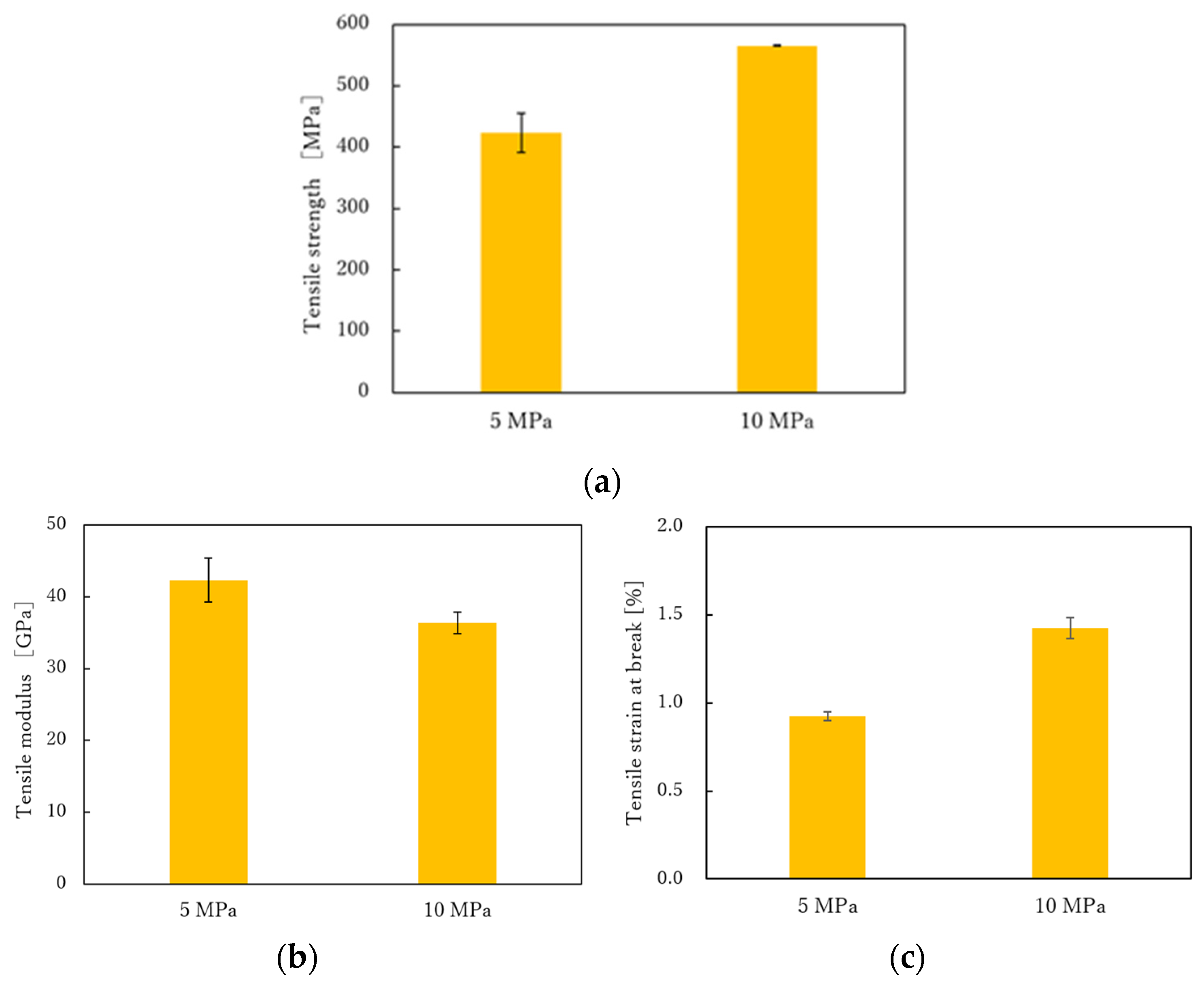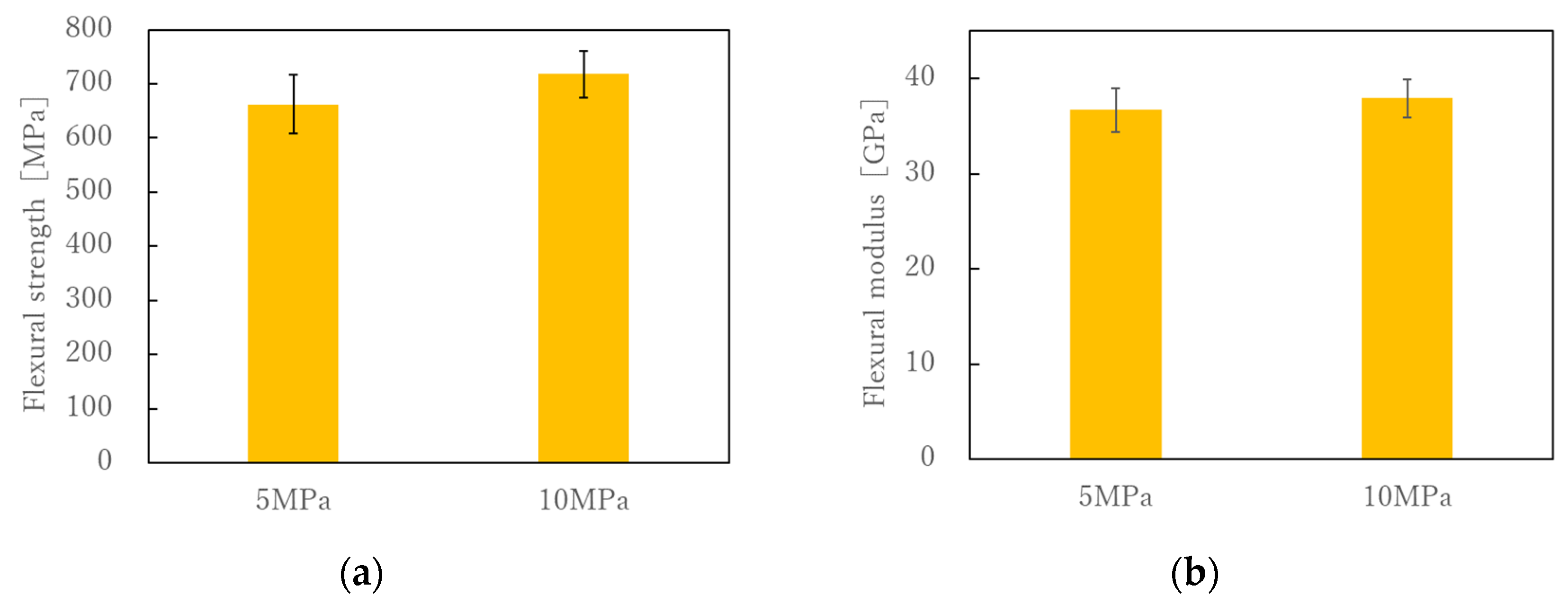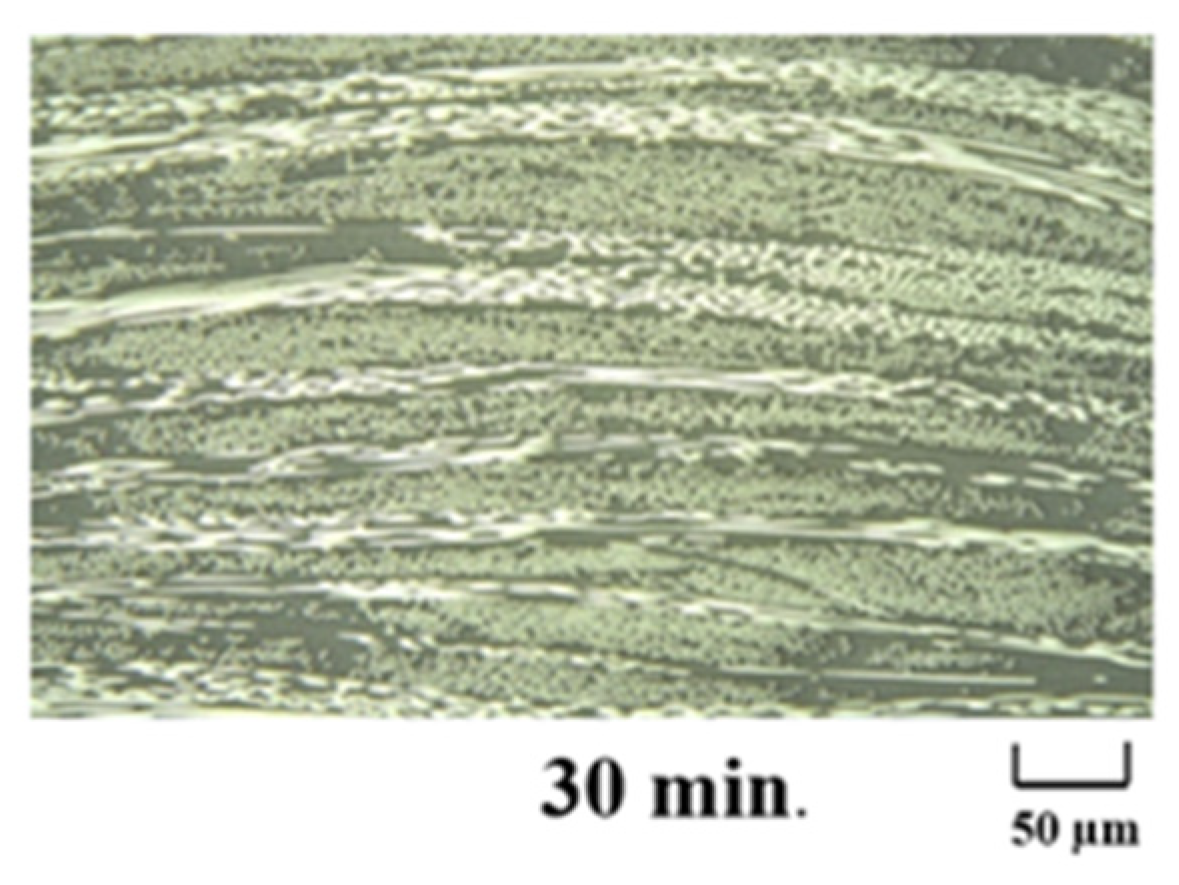Mechanical Properties of Thermoplastic Composites Made of Commingled Carbon Fiber/Nylon Fiber
Abstract
:1. Introduction
2. Materials and Methods
2.1. Material
2.2. Press Molding
2.3. Press-Forming Conditions
- The spread commingled yarn fabric was laminated in advance using any number of layers and any lamination configuration, then dried in a vacuum dryer for at least 15 h at 80 °C.
- After it was confirmed that the mold had reached the desired molding temperature, the laminated spread commingled yarn fabric was removed from the vacuum dryer and fed into the mold.
- To melt the nylon fibers, preheating was performed under 1 MPa pressure for 5 min.
- The mold was maintained at a predetermined pressure (molding pressure) and for a predetermined time (molding time).
- After the heat molding was completed, the mold was unclamped, lifted off the hot plate by the die lifter, transferred from the heating plate to the cooling plate at room temperature, and cooled again by applying the desired pressure (molding pressure).
- After the mold temperature was confirmed to be below 80 °C the mold was opened by the press machine and the molded product was demolded using ejector plate.
2.4. Tensile Test and Four-Point Flexural Test
2.5. Measurement of Fiber Volume Content
2.6. Confirmation of Resin Impregnation to the Interior of the Carbon Fiber
3. Results
3.1. Fiber Volume Content
3.2. Tensile Test
3.3. Four-Point Flexural Test
4. Discussion
5. Conclusions
- The impregnation speed of the nylon resin into the carbon fiber bundles were very fast: less than 1 min. As the molding time increased, the tensile strength and tensile fracture strain slightly decreased, indicating the deterioration of the the nylon resin. As the molding pressure increased, the amount of matrix resin flowing out increased and the fiber volume fraction of the molded product increased, resulting in an increase in tensile strength and tensile strain at break.
- The effects of molding time on flexural strength, flexural modulus, and flexural fracture strain were negligible.
- As a result of the cross-sectional observation conducted to confirm the impregnation state of the matrix resin, no voids were observed in the molded products regardless of the molding time or molding pressure, indicating that resin impregnation into the carbon fiber bundles of the spread commingled yarn fabric was completed at a molding pressure of 5 MPa and a molding time of 5 min.
- The combination of commingled yarn, spread fiber, and woven fabric suggested the possibility of flexible and easy-to-handle thermoplastic CFRP prepreg.
- This is the first study on CFRTP using spread commingled carbon fiber and nylon fiber yarns as woven fabric.
Author Contributions
Funding
Institutional Review Board Statement
Informed Consent Statement
Acknowledgments
Conflicts of Interest
References
- Okumura, W.; Hasebe, H.; Kimizu, M.; Ishida, O.; Saito, H. Development of Carbon Fiber Fabric Reinforced Polypropylenes—Part 1: Effect of Content of Maleic Acid and Removal of Sizing Agent—. Sen’i Gakkaishi 2013, 69, 177–182. [Google Scholar] [CrossRef] [Green Version]
- Kobayashi, S.; Tanaka, A.; Morimoto, T. Analytical prediction of resin impregnation behavior during processing of unidirectional fiber reinforced thermoplastic composites considering pressure fluctuation. Adv. Compos. Mater. 2012, 21, 425–432. [Google Scholar] [CrossRef]
- Ueda, H.; Okumura, W.; Uematsu, H.; Tanoue, S. Processing of Carbon Fiber Fabric Reinforced Polycarbonate—Formation Mechanism of void. J. Fiber Sci. Technol. 2016, 72, 244–250. [Google Scholar] [CrossRef] [Green Version]
- Nedanov, P.B.; Advani, S.G. A Method to Determine 3D Permeability of Fibrous Reinforcements. J. Compos. Mater. 2002, 36, 241–254. [Google Scholar] [CrossRef]
- Batchelor, G.K. Transport Properties of Two-Phase Materials with Random Structure. Ann. Rev. Fluid. Mech. 1974, 6, 227–255. [Google Scholar] [CrossRef]
- Jespersen, S.T.; Wakeman, M.D.; Michaud, V.; Cramer, D.; Manson, J.-A.E. Film stacking impregnation model for a novel net shape thermoplastic composite preforming process. Compos. Sci. Technol. 2008, 68, 1822–1830. [Google Scholar] [CrossRef]
- Miller, A.; Wei, C.; Gibson, A. Manufacture of polyphenylene sulfide (PPS) matrix composites via the powder impregnation route. Compos. Part A 1996, 27, 49–56. [Google Scholar] [CrossRef]
- Padaki, S.; Drzal, L.T. A simulation study on the effects of particle size on the consolidation of polymer powder impregnated tapes. Compos. Part A 1999, 30, 325–337. [Google Scholar] [CrossRef]
- Ramasamy, A.; Wang, Y.; Muzzy, J. Braided thermoplastic composites from powder-coated towpregs. Part I: Towpreg characterization. Polym. Compos. 1996, 17, 497–504. [Google Scholar] [CrossRef]
- Oleg, S.; Till, Q.; Richard, H.; Thomas, G. Commingled composites. Fiber Reinf. Compos. 2021, 439–460. [Google Scholar] [CrossRef]
- Kwon, D.-J.; Kim, N.-S.-R.; Jang, Y.-J.; Choi, H.H.; Kim, K.; Kim, G.-H.; Kong, J.; Nam, S.Y. Impacts of thermoplastics content on mechanical properties of continuous fiber-reinforced thermoplastic composites. Compos. Part B Eng. 2021, 216, 108859. [Google Scholar] [CrossRef]
- El-Dessouky, H.M.; Liu, B.; Saleh, M.N.; Scaife, R.J. Co-woven carbon and nylon fibres for manufacturing thermoplastic composite plaques. Procedia CIRP 2019, 85, 272–276. [Google Scholar] [CrossRef]
- Bernet, N.; Michaud, V.; Bourban, P.-E.; Manson, J.-A.E. Commingled yarn composites for rapid processing of complex shapes. Compos. Part A 2001, 32, 1613–1626. [Google Scholar] [CrossRef]
- McDonnell, P.; McGarvey, K.P.; Rochford, L.; Bradaigh, C.M.O. Processing and mechanical properties evaluation of a commingled carbon-fibre/PA-12 composite. Compos. Part A 2001, 32, 925–932. [Google Scholar] [CrossRef]
- Gilchrist, M.D.; Sevensson, N.; Shishoo, R. Fracture and fatigue performance of textile commingled yarn composites. J. Mater. Sci. 1998, 33, 4049–4058. [Google Scholar] [CrossRef] [Green Version]
- Kim, D.H.; Lee, W.I.; Friedrich, K. A model for a thermoplastic pultrusion process using commingled yarns. Compos. Sci. Technol. 2001, 61, 1065–1077. [Google Scholar] [CrossRef]
- Boourban, P.-E.; Bernet, N.; Manson, J.-A.E. Material phenomena controlling rapid processing of thermoplastic composites. Compos. Part A 2001, 32, 1045–1057. [Google Scholar] [CrossRef]
- Hamada, H.; Fujita, A.; Nakai, A. Design Methodology for Braided Composite Tubes: 1st Report, Bending Properties. Jpn. Soc. Mech. Eng. 1995, 61, 1460–1466. [Google Scholar] [CrossRef] [Green Version]
- Nakai, A. Processing for Continuous Fiber Reinforced Thermoplastic Composites by Braiding Technique. J. Jpn. Soc. Tech. Plast. 2014, 55, 602–606. [Google Scholar] [CrossRef]
- Ma, Y.; Jin, S.; Yokozeki, T.; Ueda, M.; Yang, Y.; Elbadry, E.A.; Hamada, H.; Sugahara, T. Effect of hot water on the mechanical performance of unidirectional carbon fiber-reinforced nylon 6 composites. Compos. Sci. Technol. 2020, 200, 108426. [Google Scholar] [CrossRef]
- Ma, Y.; Yokozeki, T.; Ueda, M.; Sugahara, T.; Yang, Y.; Hamada, H. Effect of polyurethane dispersion as surface treatment for carbon fabrics on mechanical properties of carbon/Nylon composites. Compos. Sci. Technol. 2017, 151, 268–281. [Google Scholar] [CrossRef]
- Sakai, T.; Shamsudim, N.S.B.; Fukushima, R.; Kageyama, K. Effect of matrix crystallinity of carbon fiber reinforced polyamide 6 on static bending properties. Adv. Compos. Mater. 2021, 30, 71–84. [Google Scholar] [CrossRef]
- Uematsu, H.; Kurita, D.; Nakakubo, S.; Yamaguchi, A.a.; Yamane, M.; Kawabe, K.; Tanoue, S. Mechanical behavior of unidirectional carbon fiber-reinforced polyamide 6 composites under transverse tension and the structure of polyamide 6 among carbon fibers. Polym. J. 2020, 52, 1195–1201. [Google Scholar] [CrossRef]
- Zhang, J.M.; Reynolds, C.T.; Peijs, T. All-poly(ethylene terephthalate) composites by film stacking of oriented tapes. Compos. Part A 2009, 40, 1747–1755. [Google Scholar] [CrossRef]
- Ali, R.; Iannace, S.; Nicolais, L. Effects of processing conditions on the impregnation of glass fibre mat in extrusion/calendaring and film stacking operations. Compos. Sci. Technol. 2003, 63, 2217–2222. [Google Scholar] [CrossRef]
- Kawabe, K.; Matsuo, T.; Maekawa, Z. The Impregnation Behavior of Matrix Resin into the Opened Reinforcing Fiber Tows. J. Soc. Mat. Sci. Jpn. 1998, 47, 735–742. [Google Scholar] [CrossRef]
- Toyota, K.; Okubo, K.; Fujii, T.; Oguri, T.; Uenoya, T.; Sugawara, T. Mechanical Properties of Plain-woven CFRP Reinforced by Spread Fiber Tow During and After Drop-weight Impact. WIT Trans. Built Environ. 2006, 87, 455–464. [Google Scholar]
- EL-Dessouky, H.M.; Lawrence, C.A. Ultra-lightweight carbon fibre/thermoplastic composite material using spreadeded tow technology. Compos. Part B Eng. 2013, 50, 91–97. [Google Scholar] [CrossRef]
- Motochika, T.; Takagi, M. Application of Semi-Impregnated Intermediate Materials for CFRTP to Textile Composites. Proc. Annu. Meet. Soc. Text. Mach. Soc. Jpn. 2019, 72, 68–69. [Google Scholar]
- Yoon, H.; Takahashi, K.; Kojima, K.; Kon, Y. Resistance to transverse tension of a commingled carbon fiber/poly (ether ether ketone) composite. Sen’i Gakkaishi 1991, 47, 76–83. [Google Scholar] [CrossRef] [Green Version]

















| Matrix resin | Low-water-absorbing nylon MXD10 (LEXTER manufactured by Mitsubishi Gas Chemical Co. Ltd., Japan) 1532 filaments (3.125 d mono-filament) |
| Carbon fiber | PAN CF (Mitsubishi Chemical Co. Ltd. TR50S12L, Japan) 12,000 filaments |
| Designed value of fiber volume content () | 50% |
| Weave Structure | Plain |
|---|---|
| basis weight | 107.5 g/m2 |
| Thickness | 244.6 µm |
| Fiber volume content () | 41.5 % |
| Length | Width | Layer Number |
|---|---|---|
| 245 mm | 245 mm | 30 ply |
| Molding Temperature | Preheating | Molding Time | Molding Pressure |
|---|---|---|---|
| 270 °C | 1 MPa, 5 min | 5 min, 10 min 20 min, 30 min | 5 MPa, 10 MPa (30 min) |
| Test Specimen Longitudinal Direction | Warp Direction | |
|---|---|---|
| Test specimen dimensions | length | 240 mm |
| width | 25 mm | |
| thickness | 2 + 0.4 mm | |
| Distance between two lines of sight | 50 mm | |
| Distance between tabs | 150 mm | |
| Tab Length | 45 mm | |
| Tensile test speed | 2 mm/min. | |
| Sample number | 5 | |
| Test Specimen Longitudinal Direction | Warp Direction | |
|---|---|---|
| Test specimen dimensions | length | 100 mm |
| width | 15 mm | |
| thickness | 2 ± 0.4 mm | |
| Distance between fulcrums | 88 mm | |
| Distance between indenters | 29 mm | |
| fulcrums radius | 3 mm | |
| indenters radius | 3 mm | |
| Flexural test speed | 5 mm/min. | |
| Sample number | 6 | |
| Molding Time | 5 min | 10 min | 20 min | 30 min | 30 min |
|---|---|---|---|---|---|
| Molding pressure | 5 MPa | 10 MPa | |||
| Fiber volume fraction () | 38.9% | 38.7% | 38.3% | 38.6% | 48.7% |
Publisher’s Note: MDPI stays neutral with regard to jurisdictional claims in published maps and institutional affiliations. |
© 2021 by the authors. Licensee MDPI, Basel, Switzerland. This article is an open access article distributed under the terms and conditions of the Creative Commons Attribution (CC BY) license (https://creativecommons.org/licenses/by/4.0/).
Share and Cite
Ono, M.; Yamane, M.; Tanoue, S.; Uematsu, H.; Yamashita, Y. Mechanical Properties of Thermoplastic Composites Made of Commingled Carbon Fiber/Nylon Fiber. Polymers 2021, 13, 3206. https://doi.org/10.3390/polym13193206
Ono M, Yamane M, Tanoue S, Uematsu H, Yamashita Y. Mechanical Properties of Thermoplastic Composites Made of Commingled Carbon Fiber/Nylon Fiber. Polymers. 2021; 13(19):3206. https://doi.org/10.3390/polym13193206
Chicago/Turabian StyleOno, Mizuki, Masachika Yamane, Shuichi Tanoue, Hideyuki Uematsu, and Yoshihiro Yamashita. 2021. "Mechanical Properties of Thermoplastic Composites Made of Commingled Carbon Fiber/Nylon Fiber" Polymers 13, no. 19: 3206. https://doi.org/10.3390/polym13193206





